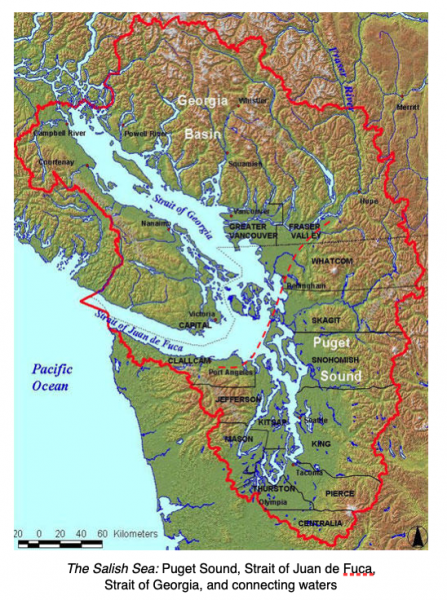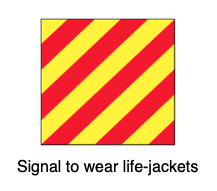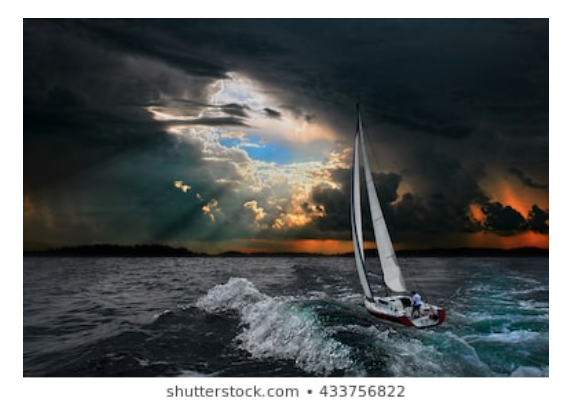
By Roland Nikles
Thunderbird 1177 “Falcon”
More than seven million people live in the Salish Sea basin, which contains two of North America’s most vibrant and growing cities. We spend most of our time in a built world, in comfortable and safely constructed buildings; we travel on well-regulated roads in safe cars, with hospitals, ambulances, and police never far away; we might on occasion be inconvenienced by snow, but mostly we are not affected by adverse weather. We take the reliability of our infrastructure and supply chains for granted and expect a quick remedy when anything goes wrong.
The moment we venture forth into the Salish Sea in small boats, things are very different. Now we are at the mercy of the weather, which can endanger life and limb. We are forced to find our way across uncertain waters, past invisible shoals and rocks, in strong currents, in wind and waves, often in fog or in dark of night. Waypoints are fewer, less reliable, more difficult to interpret. Things can go terribly wrong and when they do help is far away, harder to contact, unreliable. We are forced to be self-reliant, prepared for disaster, to fall back on ancient seafaring skills.
We have distilled some of this ancient wisdom into rules to be observed by sailors on the Salish Sea, adding a gloss of the modern administrative state to an ancient seafaring tradition. The rules of the road and mandatory lists of safety equipment have been codified to try and help keep mariners safe. They take full advantage of technological innovations that Captain Vancouver and his crews could not have imagined when he sailed upon these waters.
In Washington State, when we race a sailboat, we are subject to the requirements of three overlapping jurisdictions. First, there are the fundamental rules of the road. These are applicable to all shipping and have been adopted by international bodies and the U.S. Congress, the International Regulations for Preventing Collisions at Sea, 1972 (“COLREGS”). Second, there are boating regulations and rules established and enforced by the State of Washington, and local counties. And third, there are the race instructions of any particular sailing race, including their Safety Equipment Requirements, and the racing rules of sailing.
COLREGS
The COLREGS apply on all waters of the Salish Sea and they have the force of law. A violation of these rules can result in a $5,000 fine for each violation. 33 U.S.C. 1608. In addition, your vessel can be seized. Id. The relevant Coast Guard Publication can be found HERE.
The COLREGS mandate a lookout and safe speed at all times, establish rights of way when vessels meet, clarify the action to be taken and signals to be given by vessels for avoiding collisions, and establish priorities for maneuvering in narrow channels and around traffic separation schemes. The regulations set forth what lights and shapes must be displayed by different boats under different circumstances, during the day, and during nighttime. In order to make the prescribed signals, the regulations require all boats to carry some device for making an efficient sound signal; boats longer than 12 meters must carry a whistle; boats longer than 20 meters must carry a whistle and a bell; and boats longer than 100 meters must carry a whistle, a bell, and a gong.
Washington State Boating Rules
The Washington State legislature has established minimal equipment standards for boating by statute and directed the State Parks and Recreation Commission to enact additional regulations. RCW 79A.60.110. The regulations enacted by the Parks and Recreation Department can be found, commencing at WAC 352.060. Violations of these rules and regulations is an infraction punishable by a fine up to $500.00. Local county rules may carry separate penalties. For example, Jefferson County’s Boating Safety Code, Chapter 8.40, allows a penalty of $1,000 for each violation.
The Washington rules require a personal flotation device on board for each person on a vessel, in serviceable condition, of an appropriate size, readily accessible. RCW 79A.60.160. See WAC 352.60.030. Life jackets must meet U.S. Coast guard standards. In addition, vessels longer than 16 feet must have a throwable Type IV personal floatation device (a ring or buoyant cushion).
Boats longer than 16 feet are required to carry visual distress signals for day and night use. This is duplicative of the COLREGS but brings the added exposure of penalties from the local jurisdictions. The detailed requirements can be found at WAC 352.60.040.
The state regulations adopt the light and shape regulations of the COLREGS. They also adopt the steering and sailing rules of the COLREGS, making individual violations subject to state penalties. WAC 352-60.070.
All boats with a motor are required to carry a fire extinguisher (except boats without a cabin, less than 26 feet in length). Boats longer than 26 feet, up to 40 feet, are required to carry two fire-extinguishers. Boats longer than 40 feet must carry three fire extinguishers. WAC 352.60.080.
In addition to carrying mandated safety equipment, Washington State requires all operators of a motor driven boat of 15 hp or greater to complete a state-approved boating safety course and to carry proof of completion. RCW 79A.60.650. See information on the Park & Rec site, HERE. Coast guard licensed operators are exempt.
Sailing Instructions for Races
Regattas and races are conducted in accordance with sailing instructions. Sailing instructions, at minimum, will define the course of the race, starting times, cutoffs for finishing… and, crucially, provide details for parties and celebrations. They may impose minimal or no added safety equipment requirements, or lots of requirements. Those requirements do not have the force of law. The consequence of violation is to be penalized (e.g. adjustment of finishing time or order), or to be disqualified from the race.
The sailing instructions for the Northwest Maritime Center’s race to Alaska (R2AK), for example, are minimalist: every participant must carry a SPOT tracker (provided by the race organization), a personal locator beacon or emergency position beacon (EPIRB), a VHF radio, and the COLREG and WA state required navigation lights, flares, and lifejackets.
The sailing instructions for Port Townsend Sailing Association state that “it is expected that boats competing in PTSA events will comply with U.S. Sailing Safety Equipment Requirements, NEARSHORE category. It is strongly urged that boats racing in the distance series review and adopt pertinent requirements for the COASTAL category” (emphasis added). Under these PTSA sailing instructions, compliance with U.S. Sailing Safety Requirements is “expected” and “strongly urged,” but not required. The Racing Rules of Sailing also apply.
The Organizing Authority for the Swiftsure International Yacht Race has historically used the safety requirements established by the Pacific International Yachting Association (PIYA), with modifications. Compliance is mandatory and boats must check in for inspection after finishing. A vessel not in compliance may be referred for a protest. The Racing Rules of Sailing also apply.
The Racing Instructions for the Corinthian Yacht Club in Seattle provide that, as designated in the applicable Notice of Race, boats must comply with the equipment requirements of US Sailing US Safety Equipment Requirements (USSER), according to the category requirement identified, if any, in the Notice of Race. The Racing Rules of Sailing also apply.
The Racing Rules of Sailing
The 2017-2020 Racing Rules of Sailing, Fundamental Rules, require that competitors “shall give all possible help to any person or vessel in danger” (Rule 1.1) and that each boat “shall carry adequate life-saving equipment for all persons on board, including one item ready for immediate use, unless her class rules make some other provision. Each competitor is individually responsible for wearing a personal flotation device adequate for the conditions” (Rule 1.2).
A fundamental rule of the Racing Rules of Sailing is that “the responsibility for a boat’s decision to participate in a race or to continue racing is hers alone.” (Rule 4) Sailors must be self-reliant and each boat, and every sailor, is ultimately responsible for their own safety.
Rule 40 of the Racing Rules of Sailing provides that competitors must wear their personal floatation device if the race committee displays the “Y” flag.

Rule 48.1 provides: “When safety requires, a boat shall sound fog signals and show lights as required by the (COLREGS) or applicable government rules.” Rule 48.2 adds that all boats are required to comply with official traffic separation schemes. In Port Townsend Bay, for example, that would include staying clear of ferries.
In order to enter a race governed by the Racing Rules of Sailing, a boat must comply with the sailing instructions prepared by the race organizers. Rule 75.1.
Boats are required to comply with their class rules. Rule 78.1. Most classes will require, for example, lifelines of set dimension and tension. See e.g. J-105 Class Rules 7.11. Other classes do not require lifelines. See e.g. Thunderbirds specifications (no lifelines required). See also Rule 49.2 (referencing lifelines required by class rules) and Rule 60.2(b)(a technical committee may protest a boat if “a boat or personal equipment does not comply with the class rules.”
U.S. Sailing Safety Equipment Requirements
The U.S. Sailing Safety Equipment Requirements, and their counterpart the PIYA Safety Requirements, have no independent authority except to the extent they are adopted and incorporated by the sailing instructions for a particular race. Under the Swiftsure sailing instructions, and the Corinthian Yacht Club (Seattle) sailing instructions the selected portions are compulsory. Under the Port Townsend Sailing Association’s sailing instructions, they are entirely advisory, and the decision of which measures to adopt is up to the skipper of each boat.
The U.S. Sailing Safety Equipment Requirements have been compiled and developed over decades, with input from the US sailing community. The goal is to assist race organizers to specify prudent safety equipment requirements for individual races. The SERs attempt to set out clear requirements for yacht owners, race organizers, and inspector to understand, follow, and implement. The SERs are self-contained and do not refer to external documents. A printable format of the SERs can be found at the PTSA website, HERE.
The requirements of the SER’s are divided into three race categories: Nearshore, Coastal, and Ocean. Race organizers are encouraged to add or delete gear requirements based on the nature of individual races.
The Swiftsure committee designates the PIYA “Coastal” requirements for each of the four long races out the Strait of Juan de Fuca, with some modifications. The Port Townsend Sailing Association recommends the “Coastal” requirements for its long-distance races and the “Nearshore” requirements for races on Port Townsend Bay.
The SER Coastal Requirements include general requirements regarding hull integrity, such as the ability to keep out water, drain a cockpit timely, pump water from a cabin with bilge pumps, and the general ability to handle heavy seas, as well as general requirements regarding lifeline and bow pulpit specifications, and an engine able drive the boat at hull speed for at least four hours.
Here is a partial list of some specific safety gear called for by the SER Coastal category:
- lifejackets;
- safety harnesses and jacklines to secure them to;
- a life-sling or equivalent man-overboard rescue device;
- meeting the COLREG and state requirements;
- a VHF radio with a top of mast mounted antenna in addition to a handheld VHF;
- a GPS receiver;
- a 406 MHz EPIRB properly registered to the boat;
- a depth-sounder;
- a magnetic compass suitable for steering at sea;
- non-electronic charts for the race area;
- tapered plugs for every through-hull fitting;
- an anchor and chain and sufficient rode;
- a high-powered search light;
- at least two watertight flashlights;
- a first aid kit;
- a radar reflector;
- two sturdy buckets with lanyards attached;
- a mainsail reefing capable of reducing the luff length at least 10%
In addition, the SERs require crew training. The crew should be able to steer the vessel with a disabled rudder. Man-overboard drills should be conducted annually. At least 30 percent of a crew, and not less than two, should have completed a US Sailing Safety at Sea seminar within the past five years. Everyone on board should know where safety equipment is located and how to operate it. Lifejackets should be worn at all times when recovery would be difficult, such as in heavy seas, heavy wind, or at night.

The COLREGS and Washington State regulations must be studied and mastered by everyone venturing forth into the Salish Sea under penalty of law. In addition, the U.S. Sailing Safety Equipment Requirements, and their counterpart the PIYA requirements, are a valuable resource and should be valued, consulted, and thought about anytime we venture forth into the Salish Sea on small boats no matter the sailing instructions that apply. They are meant to keep us and our crews safe.
Good seamanship, knowledge of the COLREGS and applicable regulations, and due regard to the guidance and experience passed down through the SER’s and PIYA “requirements,” will put us in good stead in a difficult situation, whether we are racing or not.
